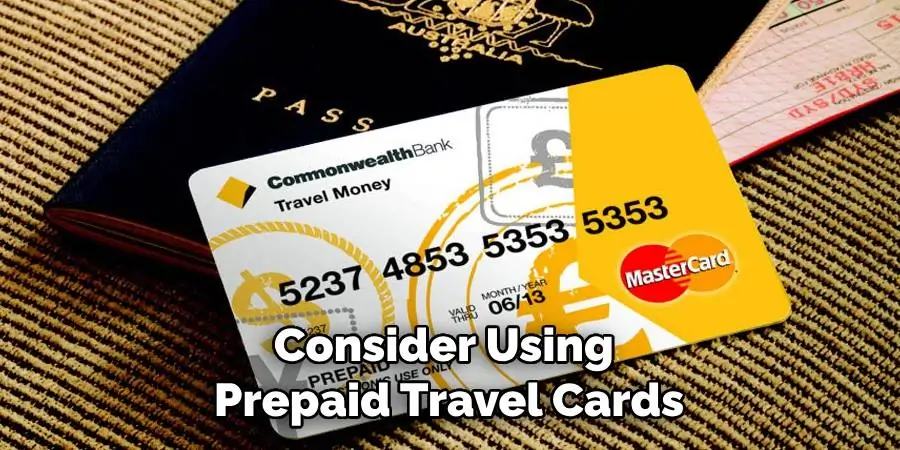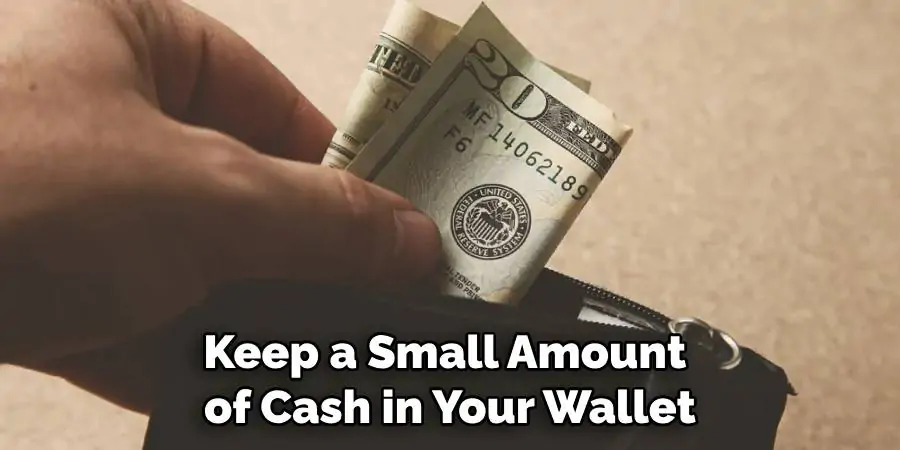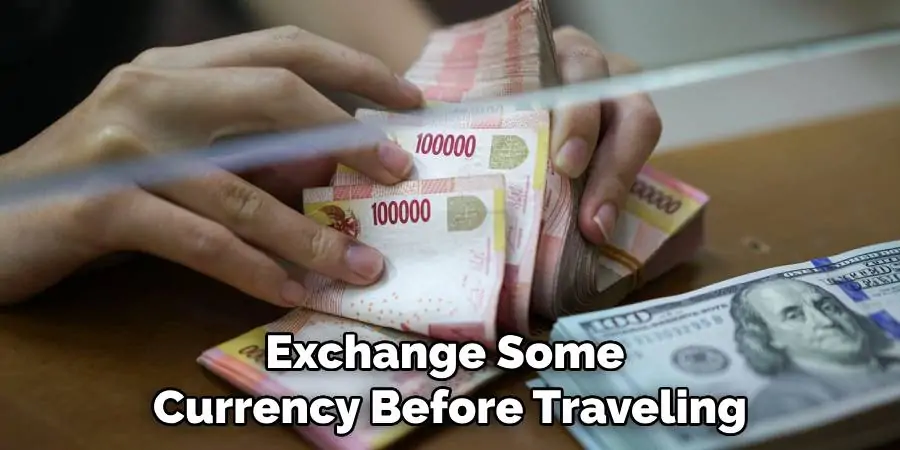Traveling is an exciting experience that allows us to explore new cultures, try different cuisines and create unforgettable memories. However, carrying money while traveling can be a daunting task. With the constant threat of theft or loss, it’s important to have a plan in place to ensure your funds are safe during your trip. In this guide, we’ll provide you with some tips on how to carry money when traveling.

How to Exchange Currency Before Traveling
Before embarking on your trip, it’s important to exchange your currency for the local currency of the country you’ll be visiting. This can be done at your local bank or a reputable currency exchange service. It’s best to avoid exchanging money at airports or tourist areas as they often offer unfavorable exchange rates.
Research the Exchange Rate
Before exchanging your money, it’s important to research the current exchange rate for the country you’ll be visiting. This will give you an idea of how much money you should exchange and help you avoid being overcharged.
Use Credit or Debit Cards
Using credit or debit cards can be a convenient and safe way to carry money while traveling. However, it’s important to inform your bank beforehand about your travel plans to avoid any issues with your card being blocked for potential fraudulent activity. Additionally, be aware of foreign transaction fees and try to use cards that offer minimal or no fees.
Carry Multiple Forms of Currency
It’s always a good idea to carry multiple forms of currency when traveling. This can include cash, credit or debit cards, and even traveler’s checks. In case of an emergency, having different forms of currency will ensure that you have access to funds.
11 Smart Ways on How to Carry Money When Traveling
When traveling, it’s essential to strike a balance between safety and accessibility when carrying money. Here are some guidelines and tips to help you carry money safely and elegantly while traveling:
1. Divide Money
Divide your money into multiple safe spots, both on your person and in your luggage. This way, if one of your bags gets lost or stolen, you won’t lose all of your funds. Keep a portion of your money in easily accessible places for daily expenses, while the bulk of it should be stored more securely. Consider using hidden pockets, money belts, or a neck wallet worn under your clothes to keep larger sums safe.

2. Favor On-Body Storage
Use under-clothing storage accessories like bra stashes, long johns, or undershirts with built-in pockets for storing money and important documents. These options offer a discreet way to carry valuables and are particularly useful in crowded places where pickpocketing might be a concern. They allow for easy access to your belongings while ensuring they remain hidden from sight.
3. Keep Small Bills Handy
Make smaller denominations of currency easily accessible for tipping, public transportation, or small purchases. This way, you won’t have to flash larger sums of money when making everyday transactions.
4. Adapt to the Local Money Culture
Be prepared to pay your way on vacation, which means different things in different countries. In some places, cash is king, and you’ll find that even smaller purchases require paper money over plastic cards. Meanwhile, in other destinations, digital payments and credit cards are widely accepted, even for buying a cup of coffee. It’s crucial to adapt to the local money culture of your destination to smooth out transactions and avoid any financial faux pas. Do some research or ask locals for advice on the preferred payment methods to ensure you’re always prepared.
5. Prepaid Travel Cards
Consider using prepaid travel cards that support multiple currencies. These cards offer secure and convenient access to funds, and you can top them up as needed. They also come with features such as locking in a favorable exchange rate and the ability to cancel the card if it’s lost or stolen.

6. Money Belts and Travel Wallets
Use money belts or travel wallets that incorporate RFID-blocking technology to safeguard your credit and debit cards from unauthorized scanning. These accessories come in various designs and can be worn under clothing or attached to a belt loop, providing easy access to your money while keeping it secure.
7. Hotel Safes
If you don’t want to carry all your cash and cards with you, consider using a hotel safe to store them while exploring your destination. Most hotels offer this service, and it’s a reliable option for keeping your funds safe.
8. Create a Diversion
Carry a dummy wallet to deter thieves from getting the real deal. Fill it with some small bills and expired credit cards to use as a diversion in case of a robbery. This can be particularly effective in dissuading thieves quickly without risking your actual valuables. Always remember to hand over the dummy wallet calmly in such situations, as the primary goal is to avoid confrontation and ensure your safety.
9. Be Alert at the ATM
When using an ATM, seek out ones located inside a building, and be sure to cover the keypad when entering your PIN. Also, be aware of your surroundings and any suspicious individuals before and after using the ATM.
10. Yoga Belts and Running Belts
Consider using yoga belts or running belts as an alternative to money belts. These accessories can be worn around your waist and offer a convenient way to carry money, credit cards, and other small items. They are also more discreet than traditional money belts.
11. Everyday Items

Use everyday items like hair scrunchies, paper book safes, lipstick, tissue and gum packs, sunscreen, hairbrushes, water bottles, deodorant, and money socks to hide cash while traveling. These items offer a creative and inconspicuous way to conceal your money and keep it safe from potential theft. So, next time you’re packing for a trip, consider using everyday items as secret hiding spots for your cash and cards.
Remember, the key to carrying money when traveling is to strike a balance between safety and accessibility. Utilize these tips and tricks to ensure that you have access to funds while staying safe during your travels.
Additional Tips for Carrying Cash Safely
- Keep a small amount of cash in your wallet for easy access and use.
- Always keep an eye on your belongings, especially when in crowded areas or public transportation.
- Consider using a money clip instead of a bulky wallet to minimize the risk of pickpocketing.
- Avoid carrying large amounts of cash on you, and only withdraw money from secure ATMs.
- Use a hidden compartment in your luggage or clothing to keep emergency cash.
In conclusion, there are various ways to carry money safely when traveling. It’s important to be prepared and have multiple options for carrying money, as well as being aware of the local money culture of the country you’re visiting. By following these tips, you can enjoy your trip without worrying about the safety of your money. So, always be alert and prepared while traveling and have a great trip! Keep these tips in mind for your next adventure.

What Are the Pros and Cons of Using a Money Belt While Traveling?
Money belts are a popular option for travelers looking to secure their cash and valuables while on the go. Here are some pros and cons to consider before deciding if a money belt is the right choice for you:
Pros:
- Concealed and Discreet: Money belts can be worn underneath clothing, making it difficult for pickpockets or thieves to access.
- Hands-free: With a money belt, you can keep your cash and valuables close to you without having to hold onto them or worry about putting them down somewhere.
- RFID-Blocking Technology: Some money belts come with RFID-blocking technology, which helps protect your credit and debit cards from unauthorized scanning.
- Can Be Worn While Active: Money belts are designed to be worn comfortably during activities like hiking or sight-seeing, making them a great option for travelers on the go.
Cons:
- Uncomfortable: Money belts can be bulky and uncomfortable to wear, especially in warmer climates.
- Limited Space: Most money belts have limited storage space, so you may not be able to carry all your cash and valuables with you.
- Can Be Noticeable: Depending on what you’re wearing, a money belt may be noticeable under your clothes.
- Not always secure: If someone knows you’re wearing a money belt, they may still try to steal it from you.
Overall, money belts can be a useful tool for keeping your cash and valuables safe while traveling. However, it’s important to weigh the pros and cons before deciding if a money belt is the right choice for you. Additionally, it’s always a good idea to have multiple options for carrying money while traveling and to be aware of your surroundings to avoid potential theft or loss. Stay safe and enjoy your travels!
You Can Check it Out to Pack a Suit for Travel
Frequently Asked Questions
Is It Better to Carry Cash or Card When Traveling?
It is recommended to carry a combination of both cash and cards when traveling. Cash can be convenient for smaller purchases and tips, while cards offer a more secure option for larger transactions. Consider carrying a small amount of cash in your wallet for easy access, but also have a backup credit or debit card stored safely in your money belt or hotel safe.
Should I Exchange Currency Before Traveling?
It’s usually best to exchange some currency before traveling to your destination. This way, you’ll have cash on hand for immediate expenses such as transportation or food upon arrival. However, it may also be beneficial to wait and exchange money at a local bank or reputable currency exchange company once you arrive, as they often offer better rates.

Is It Safe to Use ATMs Abroad?
Yes, it is generally safe to use ATMs abroad. However, be cautious of using unsecured or unfamiliar ATMs and always cover the keypad when entering your PIN. It’s also a good idea to withdraw money during daylight hours and in well-lit areas.
Conclusion
In this guide, we’ve discussed various tips and tricks for how to carry money when traveling. It’s important to have a secure way to carry your cash and valuables, as well as being aware of potential risks in your destination country. With the right precautions, you can enjoy your travels without worrying about the safety of your money. Keep these tips in mind for your next adventure and have a great trip! Stay safe and happy travels!
